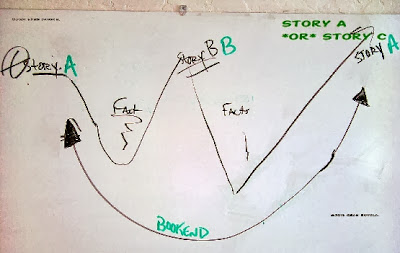I remember seeing the "Helllo, Dolly!" musical in Phoenix presented by a Broadway touring company. Carol Channing, who was so closely associated with the role of Dolly, was the lead of that tour. During the applause at the end of one song, she looked up to my balcony seat and smiled at me. It seemed that she held that glance for several seconds and then moved on. It was such a striking moment for me that even twenty-five years later I can remember this look from Ms. Channing.
 |
| Learn to Use Eye Contact in Storytelling. |
I know that, because of the lighting in the theater, she could not actually see me, but she knew someone was up there in the front row of the balcony, so she created a moment of eye contact wherein the person in that seat would feel like she was engaging them directly. It worked.
Storytelling is an art form and communication technique that requires the presence of an audience. If you cannot look your audience in the eye while you are speaking, you are not storytelling. You might be doing any of a dozen other good-and-wonderful art forms or communication methods but it isn’t storytelling. Storytelling requires a present audience.
Since your audience is right there with you, you will need to look at them. Here are six things you need to know about eye contact.
1. Remove your sunglasses from your face, hat from your head and hair from your eyes. Unless you have a medical reason for wearing any of those vision-blocking items, be sure your audience can see your face.
2. Meet and greet the group as people arrive for your presentation. However, in modern times and especially as a storyteller, be available to the audience as they arrive. Simple questions such as "How are you?" and "How did you find out about this event?" are good ways to break the ice with folks. Shaking some hands, introducing yourself and asking a simple question is a good way to establish rapport that you will want while you tell stories.
3. As you tell stories, look at your audience. Do not look over the heads of the audience or look at the back of the wall. Look into the eyes of your listeners. Linger a moment at each pair of eyes and then move on. You might want to seek out some of the folks from step two that you established a good rapport with. If an audience member reacts positively to your look, you might want to come back to them. If an audience member looks away or otherwise reacts uncomfortably, just move on. There are many reasons that people will and will not look at you. Do not make it your crusade to force people to look at you.
4. Sometimes holding the gaze of an audience member as you deliver an especially important line in your story can be very effective. As well, a long and non-threatening gaze can help settle an especially rambunctious child or teen.
5. When looking at your audience, try to avoid moving your head and eyes in any particular pattern.
6. If you are a parent telling stories to your children, know that looking them in the eye is a precious gift. This eye contact is probably the most important storytelling technique you will learn in these lessons.
Although my experience in the theater so many years ago was in a large crowd, I can think of other times when a speaker in our small group used the same eye-contact power. To improve your storytelling, looking at your audience members is a powerful tool to creating memorable presentations.
****
Sean Buvala takes a no-nonsense approach to teaching storytelling and has done so since 1986. He's a big believer in less-theory and more action when it comes to business storytelling. Get his "
Learn Storytelling" ebook and coaching kit to learn more.











